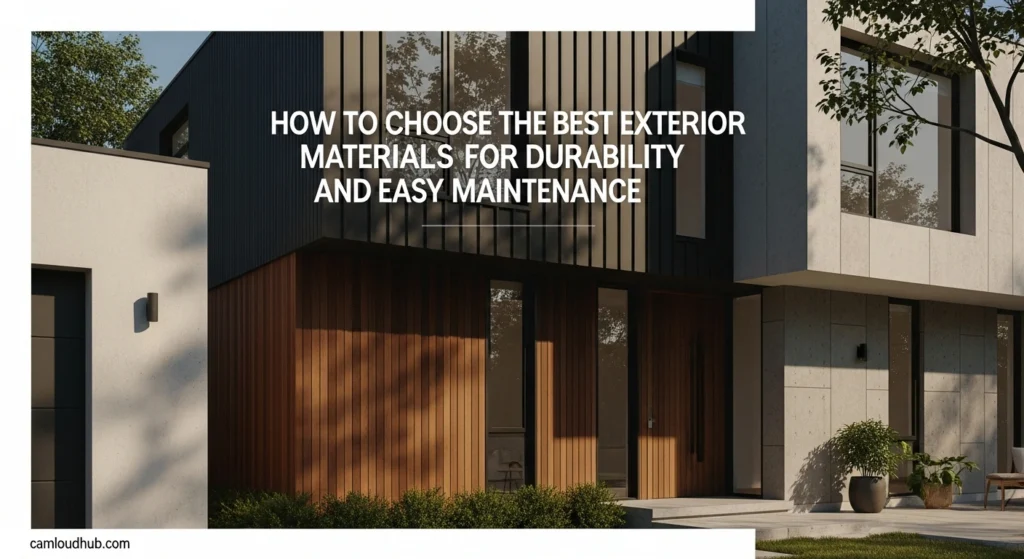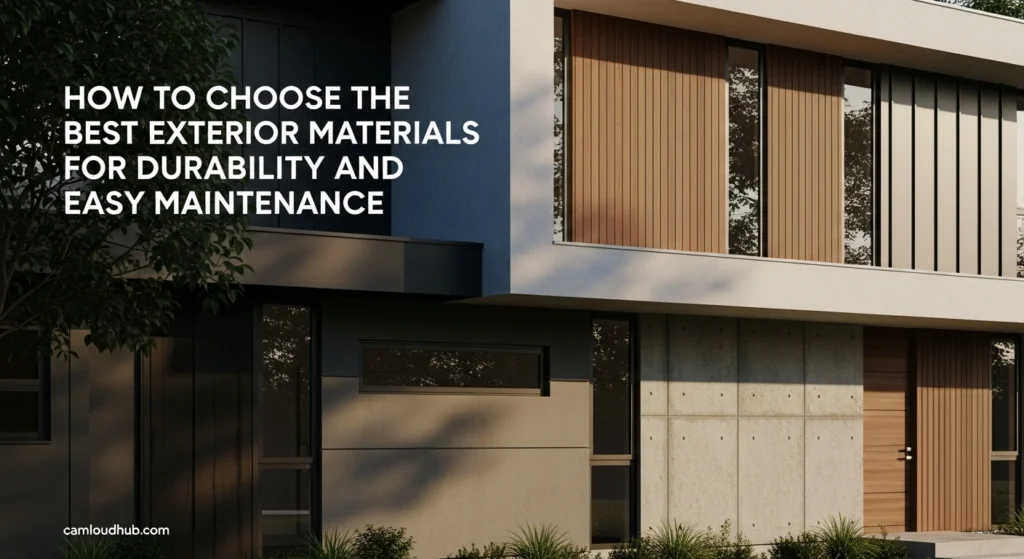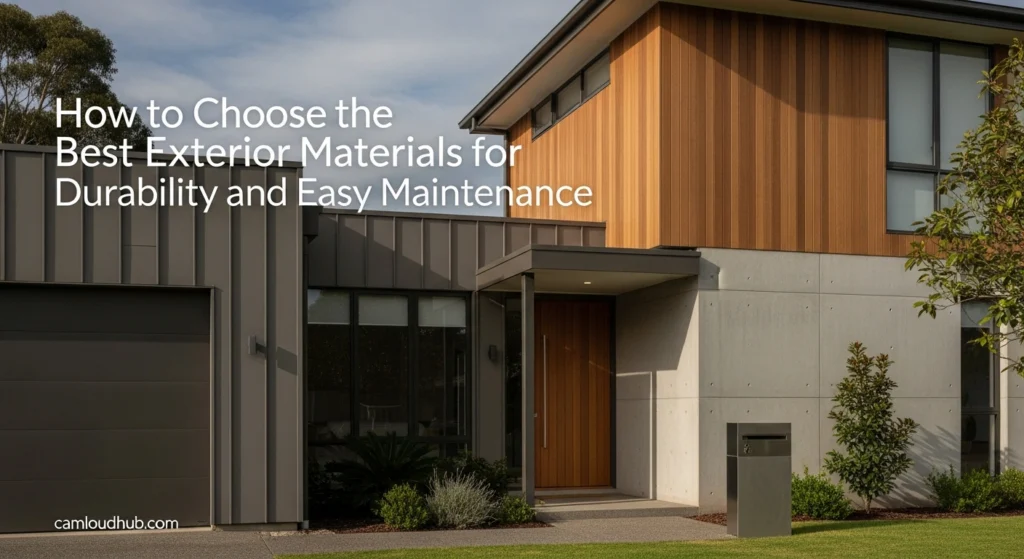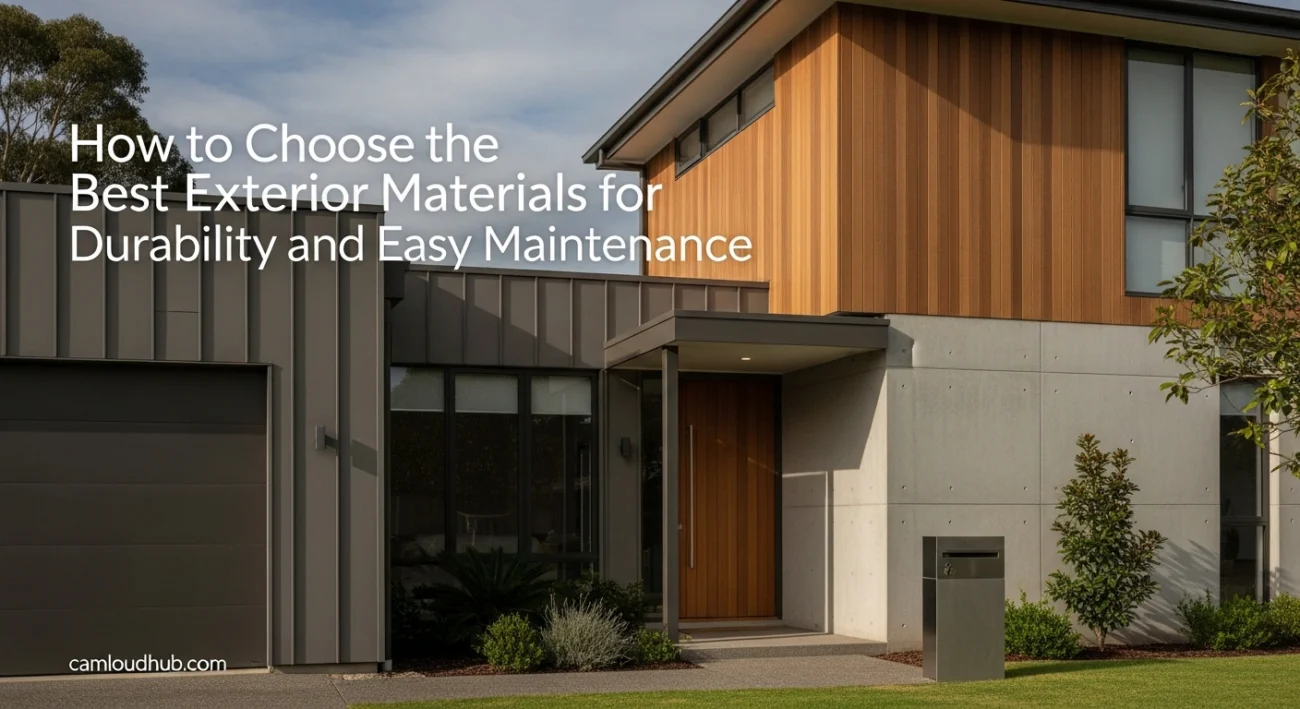How to Choose the Best Exterior Materials for Durability and Easy Maintenance
How to Choose the Best Exterior Materials for Durability and Easy Maintenance – Selecting the right exterior for a home is one of the most critical decisions a homeowner will ever make. This choice dictates not only the building’s aesthetic appeal but also its ability to withstand the elements for decades to come. The proper selection of exterior house materials directly impacts long-term costs, maintenance schedules, and the overall structural integrity of your property.
Making an informed decision requires a deep understanding of the available options, each with its unique set of a-dvantages and disadvantages. From classic brick to modern fiber cement, the market is filled with choices that cater to different budgets, climates, and architectural styles. This guide will provide a comprehensive overview to help you choose the best exterior house materials for maximum durability and minimal upkeep.

Understanding the Core Principles of Exterior Selection
Before diving into specific material options, it is essential to establish a framework for your decision-making process. Three fundamental pillars should guide your choice of exterior house materials: climate, budget, and architectural style. Evaluating these factors first will help you narrow down the field and focus on the most suitable candidates for your home.
Your local climate is arguably the most significant factor in determining material performance. A material that excels in a dry, arid region may fail prematurely in a humid, coastal environment with salt spray. Similarly, regions with extreme temperature fluctuations or heavy snowfall require exterior house materials specifically designed to handle thermal expansion, contraction, and significant moisture loads.
Finally, consider your budget not just in terms of initial installation but as a long-term investment. Some materials may have a higher upfront cost but pay for themselves over time through lower maintenance and repair expenses. Balancing the initial outlay with the total cost of ownership is key to making a financially sound decision for your exterior house materials.
A Comprehensive Guide to Popular Exterior House Materials
The market for exterior house materials is vast, offering a wide array of textures, colors, and performance characteristics. Understanding the properties of each major category is the first step toward making a choice that aligns with your goals for durability and ease of maintenance. We will explore traditional, modern, and alternative options to provide a complete picture of what is available.
Each material presents a unique balance of durability, maintenance requirements, cost, and aesthetic possibilities. Some offer unparalleled longevity with almost no upkeep, while others provide a specific look that may require more attention over the years. Examining these trade-offs is crucial for selecting the ideal exterior house materials for your specific project.
Traditional and Timeless Choices
Traditional materials have been used for centuries, and their enduring popularity is a testament to their proven performance and classic appeal. These options, including brick, stone, and wood, are often associated with quality and a timeless aesthetic. They have a long track record of protecting homes while adding significant curb appeal.
These classic exterior house materials have set the standard for residential construction for generations. While newer, engineered products have emerged, many homeowners still prefer the authentic look and feel of these time-tested options. Let’s explore the details of each to understand their suitability for a modern home focused on durability.
Brick and Stone
Brick is a champion of low-maintenance durability. Made from fired clay, it is incredibly resistant to fire, pests, and weather, and it will not rot or dent. A properly constructed brick wall can last for a century or more with very little intervention.
The maintenance required for brick is minimal, typically involving occasional cleaning to remove dirt or mildew. The mortar joints between the bricks may require repointing every few decades, but this is a minor task compared to the upkeep of other exterior house materials. The upfront cost of a brick exterior is higher than many alternatives, but its longevity makes it a sound long-term investment.
Natural stone siding offers the ultimate in durability and a unique, high-end aesthetic. Materials like granite, limestone, and slate are impervious to rot, fire, and insects, and they will easily outlast the structure they protect. No two stone exteriors are exactly alike, providing a bespoke look that adds massive value to a property.
Like brick, stone’s primary drawback is its high initial cost, which includes both the material itself and the specialized labor required for installation. Maintenance is virtually non-existent, usually limited to occasional washing. Choosing stone as one of your exterior house materials is a statement of permanence and quality.
For a more budget-friendly option, consider stone veneer. This product consists of a thin layer of real or manufactured stone applied over a solid substrate. It provides the look and feel of a full stone wall at a fraction of the cost and weight, making it a popular choice for accent walls or entire facades.

Wood Siding
Wood siding offers a natural warmth and classic beauty that many other materials try to imitate. It can be installed in various styles, such as clapboard (lap siding), shingles, or board-and-batten, allowing for significant design flexibility. Common wood species used for siding include cedar, redwood, pine, and cypress.
The primary challenge with wood as an exterior house material is its maintenance requirement. To protect it from moisture, rot, and insects, wood siding must be regularly painted, stained, or sealed every few years. Without this consistent upkeep, it can deteriorate quickly, leading to costly repairs.
Despite its maintenance needs, high-quality wood siding, when properly cared for, can be very durable. Cedar and redwood, for example, contain natural oils that make them resistant to decay and insects. The choice to use wood often comes down to a homeowner’s willingness to commit to its maintenance schedule in exchange for its unmatched natural aesthetic.
Modern and Engineered Solutions
Technological advancements have led to the creation of engineered exterior house materials that offer enhanced performance and lower maintenance compared to some traditional options. These products are designed to mimic the appearance of natural materials like wood while eliminating their vulnerabilities. They provide homeowners with a best-of-both-worlds solution: classic aesthetics with modern durability.
These materials, such as vinyl, fiber cement, and synthetic stucco, have become incredibly popular in new construction and remodeling projects. Their consistency, ease of installation, and cost-effectiveness make them attractive alternatives. They represent a significant portion of the market for exterior house materials today.
Vinyl Siding
Vinyl siding is one of the most popular and affordable siding options on the market. Made from PVC (polyvinyl chloride), it is lightweight, easy to install, and comes in a vast array of colors and textures, including many that replicate the look of wood grain. This versatility makes it suitable for a wide range of architectural styles.
From a maintenance perspective, vinyl is an excellent choice. It never needs to be painted, as the color is baked into the material itself. Its primary upkeep involves an annual washing with soap and water to remove dirt and grime.
However, vinyl’s durability has limitations. It can become brittle in extreme cold, making it susceptible to cracking from impacts. Additionally, lower-quality vinyl can fade over time with prolonged sun exposure, and it can be difficult to repair small sections without replacing an entire panel.
Fiber Cement Siding
Fiber cement is a composite material made from sand, cement, and cellulose fibers. It has emerged as a top contender among exterior house materials due to its exceptional durability and versatility. It can be manufactured to convincingly mimic the look of wood clapboard, shingles, or even stucco.
This material is incredibly tough and resistant to nearly everything. It will not rot, is impervious to termites and other pests, and is non-combustible, giving it a high fire-resistance rating. It also holds paint exceptionally well, with high-quality factory finishes often warrantied for 15 years or more.
The main downsides to fiber cement are its weight and installation complexity. It is heavier than vinyl and requires specialized tools and techniques for cutting and fastening. This translates to higher labor costs, but its longevity and low maintenance often justify the initial investment.
Synthetic Stucco (EIFS)
Synthetic stucco, also known as an Exterior Insulation and Finish System (EIFS), offers a modern take on traditional stucco. It consists of multiple layers, including a foam insulation board, a base coat with embedded fiberglass mesh, and a textured finish coat. This system provides excellent insulation properties, which can help reduce energy bills.
EIFS is lightweight and flexible, making it resistant to the cracking that can sometimes plague traditional stucco. It is available in a wide range of colors and can be applied to create smooth or heavily textured finishes. The system provides a clean, monolithic look that is popular in contemporary architecture.
The critical factor for EIFS durability is proper installation. If the system is not installed correctly, moisture can become trapped behind the finish, leading to rot in the home’s underlying structure. When selecting EIFS as one of your exterior house materials, it is imperative to hire a certified and experienced installer.
Metal and Alternative Options
Beyond traditional and common engineered products, another category of exterior house materials offers unique aesthetic and performance benefits. Metal siding, such as steel and aluminum, provides a sleek, modern look with outstanding durability. These options are increasingly being used in residential architecture for their clean lines and industrial-chic appeal.
These alternative materials are often chosen for their specific strengths, such as extreme weather resistance or unique visual style. They represent a growing segment of the market as homeowners seek out distinctive and high-performing solutions. Considering these can open up new design possibilities for your home.
Steel Siding
Steel siding is renowned for its strength and impact resistance. It will not dent easily and offers superior protection against hail, wind, and other extreme weather conditions. Modern steel siding is coated with advanced finishes to prevent rust and corrosion, and it comes in a variety of profiles, including panels that mimic wood lap siding.
One of the key advantages of steel is its extremely low maintenance. It resists fading, chalking, and cracking, and it holds its color for decades. This makes it an excellent choice for homeowners who want a “set it and forget it” solution among the available exterior house materials.
The cost of steel siding is higher than vinyl but competitive with fiber cement. Its primary potential vulnerability is scratching; if the protective coating is compromised, the underlying steel can be exposed to moisture and begin to rust. However, modern coatings are incredibly tough, making this a rare issue with quality products.
Aluminum Siding
Aluminum siding shares many benefits with steel but is more lightweight and generally more affordable. It is naturally rust-proof, making it an excellent choice for coastal areas with salt-laden air. Like steel, it comes pre-finished in a wide range of colors that are highly resistant to fading.
Because aluminum is a softer metal, it is more susceptible to denting than steel. This can be a concern in areas prone to hail or for walls near high-traffic areas like driveways. However, its lightweight nature can make installation slightly easier and less expensive.
Its low maintenance and resistance to corrosion make it a durable choice. As with all exterior house materials, proper installation is key to ensuring its long-term performance. It remains a viable and effective option, especially in specific climates.
Key Factors Influencing Your Decision
Choosing the right exterior house materials goes beyond simply comparing the pros and cons of each product. A holistic approach is required, taking into account the specific environmental pressures your home will face and your financial picture. A material that is perfect for a home in Arizona may be a disastrous choice for a home in Florida.
By carefully analyzing your region’s climate and developing a clear budget that considers both immediate and future costs, you can make a truly informed choice. This deeper analysis ensures that your selected material not only looks good on day one but also performs reliably for decades. This is the essence of selecting durable and low-maintenance exterior house materials.
Climate and Regional Considerations
Climate is a non-negotiable factor in material selection. The combination of temperature, humidity, precipitation, and sun exposure in your area will constantly test the limits of your home’s exterior. Choosing a material engineered to withstand your specific climate is the single most important step toward ensuring long-term durability.
Failing to account for climate can lead to premature failure, such as wood rotting in a damp environment or vinyl warping in extreme heat. A thoughtful selection of climate-appropriate exterior house materials will save you countless headaches and expenses down the road. Let’s break down how different climates impact material choices.
Performance in Hot and Sunny Climates
In regions with intense sun and high temperatures, the primary challenges are fading and heat absorption. Materials with light colors and reflective properties are preferable as they absorb less solar heat, which can help keep cooling costs down. Durability against UV radiation is also paramount.
Fiber cement and stucco perform exceptionally well in these environments, as they are stable under high heat and hold their color well. Lighter-colored metal siding with a high-quality, UV-resistant finish is also a great option. Dark-colored vinyl should be used with caution, as it can be prone to warping and fading under intense, direct sunlight.
Performance in Cold and Snowy Climates
In cold climates, exterior house materials must withstand freeze-thaw cycles, heavy snow loads, and potential impacts from ice. The material must resist moisture absorption, as water that freezes and expands within a material can cause it to crack and degrade. Good insulation properties are also a significant benefit.
Brick and stone are excellent performers in cold regions due to their mass and resistance to moisture. Insulated vinyl siding and fiber cement are also very popular choices, as they do not absorb water and can handle temperature swings without damage. Wood can be used but requires meticulous sealing to prevent moisture intrusion.
Performance in Humid and Rainy Climates
For coastal areas or regions with high humidity and frequent rain, the main enemies are moisture, mold, and rot. Materials must be highly resistant to water absorption and provide a drainage path for any water that gets behind them. Corrosion resistance is also a key factor in coastal zones with salt spray.
Vinyl, fiber cement, and properly treated metal siding are top choices for wet climates. They do not support mold growth and will not rot or corrode. When considering exterior house materials for these regions, it’s crucial to pair them with a high-quality weather-resistive barrier and proper flashing details to manage bulk water effectively.
Budgeting for Your Exterior: Initial Cost vs. Lifetime Value
The cost of new siding is a significant investment, and it is tempting to focus solely on the upfront price tag. However, the true cost of your exterior house materials is a combination of the initial installation price and the cumulative cost of maintenance and repairs over its entire lifespan. A cheaper material that requires frequent painting could end up being more expensive in the long run than a pricier but maintenance-free option.
A smart budgeting approach involves calculating the “lifetime value” of your investment. This means projecting the costs of cleaning, painting, sealing, and potential repairs over 20 or 30 years and adding that to the initial installation cost. This perspective often reveals that more durable, low-maintenance materials are the more economical choice over time.
Calculating Upfront Installation Costs
The initial cost of a siding project is typically broken down into two main components: materials and labor. Material costs can vary widely, with vinyl being on the lower end and natural stone on the highest. Always get quotes for the full project, including all necessary trim, accessories, and underlayments.
Labor costs are also highly variable and depend on the complexity of the material being installed. Lightweight vinyl is relatively fast and easy to install, resulting in lower labor costs. Heavier and more complex materials like fiber cement, brick, and stone require more skill and time, which increases the labor portion of the budget. It is essential to choose exterior house materials that fit within your total project budget.
The Long-Term Economics of Maintenance
This is where the true value of durable, low-maintenance exterior house materials becomes clear. Consider a wood-sided house that needs to be repainted every five to seven years. Over 30 years, that could amount to four or five full paint jobs, each costing thousands of dollars.
In contrast, a home with fiber cement or brick siding may only require occasional washing, a task a homeowner can often do themselves. The money saved on repainting and repairs over the decades can easily offset the higher initial installation cost. This long-term financial analysis is a critical part of choosing wisely.

The Role of Installation and Professional Expertise
Even the most durable and expensive exterior house materials will fail if they are not installed correctly. Proper installation is a complete system that includes the siding itself, a weather-resistive barrier, flashing around windows and doors, and proper ventilation. A mistake in any of these areas can compromise the entire system and lead to catastrophic water damage.
For this reason, selecting a qualified, experienced, and reputable contractor is just as important as selecting the right material. Always check references, look at previous work, and ensure the installer is certified or trained by the manufacturer of the product you have chosen. The quality of the installation will directly determine the longevity of your home’s exterior.
The choice of exterior house materials can feel overwhelming, but a systematic approach makes it manageable. By focusing on durability and maintenance from the outset, you can narrow your options to those that will provide the best long-term performance. Remember to always consider your specific climate as the primary filter for your decision.
Conclusion: Making the Final Choice for Your Home
Choosing the best exterior house materials for durability and easy maintenance is a balancing act. It requires weighing upfront costs against long-term value, aesthetic desires against practical performance, and material properties against the demands of your local climate. There is no single “best” material for every home; the right choice is the one that best fits your specific circumstances and priorities.
By investing time in research and careful consideration, you can select an exterior that not only enhances your home’s beauty but also protects it reliably for decades with minimal effort. Prioritize materials known for their resilience in your climate, factor in the total lifetime cost, and hire a skilled professional for the installation. This thoughtful approach will ensure your home’s exterior is a source of pride and security for many years to come, making your investment in quality exterior house materials a decision you will never regret.


